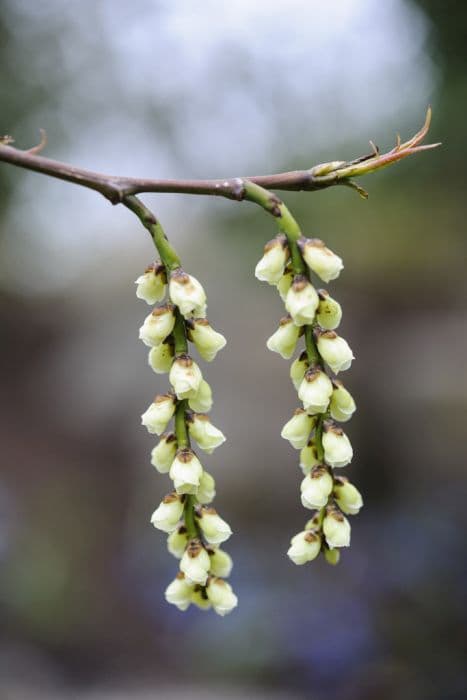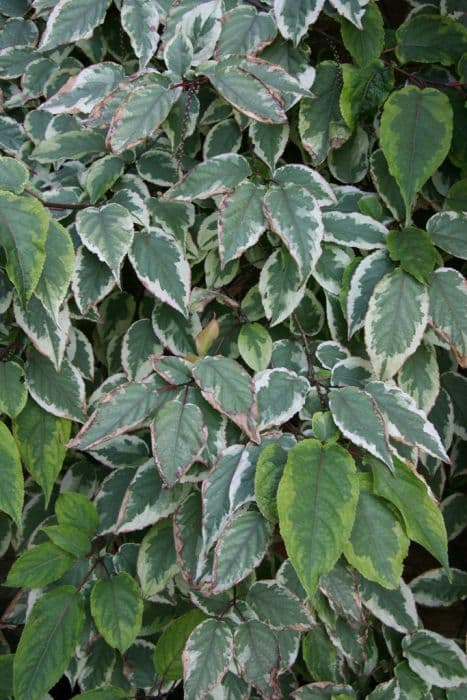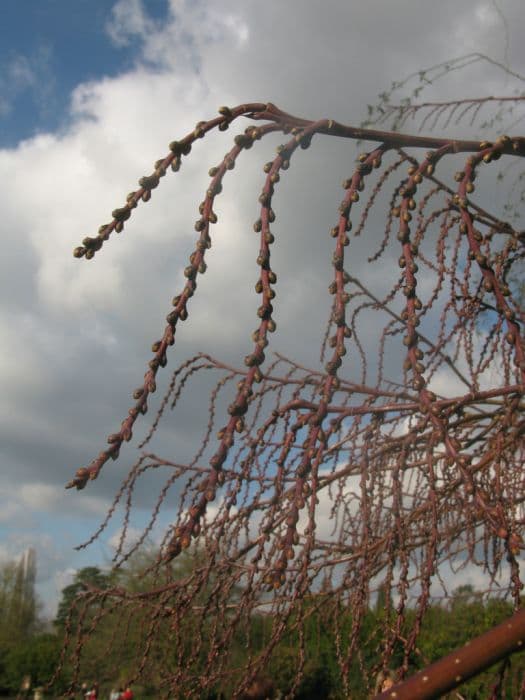Red-flowered spike tail Stachyurus 'Rubriflorus'

ABOUT
The Stachyurus 'Rubriflorus', also known as Spiketail, is a visually striking plant distinguished by its unique floral and foliar characteristics. The plant sports reddish-pink buds that create a beautiful contrast against the emerging lime-green leaves in early spring. As the season progresses, these buds unfurl into dangling chains of bell-shaped flowers, which can range in color from yellow to a creamy white, embellishing the plant with a gracefully weeping aspect. The leaves of the Spiketail are slender and pointed, forming an elongated oval shape with a delicate serration along the edges. These leaves arrange themselves in an alternate pattern along the branches, and as the seasons change, they transform from their fresh green to a stunning display of autumnal colors, including shades of yellow, orange, and sometimes a reddish-purple. The stems on which both the leaves and flowers are borne stand out with their distinct reddish tinge, adding yet another layer of color to the plant's palette. This reddish hue is particularly notable during the cooler months when it provides a warm contrast to the often bleak winter landscape. The overall impression of Stachyurus 'Rubriflorus' is one of a delicate but visually impactful plant that brings an array of colors and textures across the seasons.
About this plant
 Names
NamesFamily
Stachyuraceae
Synonyms
Red-flowering Spike-tail
Common names
Stachyurus 'Rubriflorus'.
 Toxicity
ToxicityTo humans
Stachyurus 'Rubriflorus', also known as Stachyurus, does not have a well-documented profile regarding its toxicity to humans. There is limited information available about its potential toxic effects if ingested. However, as with any plant, individual allergies and sensitivities can occur, and it is generally advisable to avoid eating ornamental plants due to the potential for adverse reactions. If you suspect poisoning from any plant, seek medical attention immediately. Symptoms could range from gastrointestinal distress to more severe reactions depending on the amount ingested and individual sensitivity.
To pets
Stachyurus 'Rubriflorus', commonly referred to as Stachyurus, is not widely known for being toxic to pets, but the lack of specific information on its toxicity means that caution should be exercised. If your pet ingests any part of this plant and you notice signs of distress such as vomiting, diarrhea, drooling, or changes in behavior, it is important to contact a veterinarian right away. The general rule of thumb is to prevent pets from chewing on or consuming parts of ornamental plants, as their toxicity profiles may not be well-established and can vary widely among different species and individual animals.
 Characteristics
CharacteristicsLife cycle
Perennials
Foliage type
Deciduous
Color of leaves
Green
Flower color
Red
Height
4-8 feet (1.2-2.4 meters)
Spread
4-8 feet (1.2-2.4 meters)
Plant type
Shrub
Hardiness zones
7
Native area
Japan
Benefits
 General Benefits
General Benefits- Ornamental Appeal: Stachyurus 'Rubriflorus', commonly known as red-flowering spike-tail, offers aesthetic beauty with its unique reddish flowers and attractive foliage.
- Landscape Interest: Red-flowering spike-tail serves as an interesting addition to gardens and landscapes, especially during its blooming season.
- Wildlife Attraction: It can attract pollinators such as bees and butterflies, enhancing the biodiversity of the garden.
- Seasonal Change: This plant provides seasonal interest with flowers in spring and potentially colorful foliage in autumn.
- Hardiness: Stachyurus 'Rubriflorus' is generally hardy and can withstand a variety of conditions once established.
- Low Maintenance: This plant typically requires minimal care beyond basic watering and occasional pruning, making it suitable for low-maintenance landscapes.
 Medical Properties
Medical PropertiesThis plant is not used for medical purposes.
 Air-purifying Qualities
Air-purifying QualitiesThis plant is not specifically known for air purifying qualities.
 Other Uses
Other Uses- Photography Accent - Spikes of bell-shaped flowers of Stachyurus 'Rubriflorus' serve as a unique foreground or background in garden photography.
- Winter Garden Interest - The vibrant, often reddish flowers provide visual interest in winter gardens when few other plants are in bloom.
- Educational Tool - This plant can be used in educational settings to teach about early spring blooming patterns and the importance of seasonal timing in plant biology.
- Seasonal Indicator - Due to its early blooming, Stachyurus 'Rubriflorus' can serve as a natural indicator of the arrival of spring.
- Botanical Art Subject - The unique structure and coloring of its flowers make the plant an excellent subject for botanical art and illustration classes.
- Privacy Screening - When planted in groups, these shrubs can develop into a natural screen, providing privacy in residential gardens.
- Theme Gardens - This plant is suitable for inclusion in Asian-themed gardens due to its native range in the Himalayas and East Asia.
- Wildlife Garden - The early blossoms of Stachyurus 'Rubriflorus' can offer an important food source for certain insects just emerging from winter dormancy.
- Cultural Symbolism - In areas where it's native or well-known, the plant might be utilized in cultural festivals or ceremonies to symbolize rebirth or renewal.
- Climate Change Research - The blooming time of Stachyurus 'Rubriflorus' might be studied as part of climate change research, monitoring shifts in phenological events.
Interesting Facts
 Feng Shui
Feng ShuiThe Stachyurus is not used in Feng Shui practice.
 Zodiac Sign Compitability
Zodiac Sign CompitabilityThe Stachyurus is not used in astrology practice.
 Plant Symbolism
Plant Symbolism- Renewal: Stachyurus, commonly known as Spiketail, typically blooms in early spring, symbolizing new beginnings and the renewal of life after winter.
- Resilience: The Spiketail is known for its hardy nature, able to thrive in various conditions, representing resilience and the ability to withstand challenges.
- Nature’s Rhythm: With its seasonal flowering, the Spiketail reminds us of the natural cycle of life and encourages respect for nature’s timing and rhythms.
- Unique Beauty: The unusual and striking appearance of the Spiketail flowers, especially the reddish hue of the 'Rubriflorus' variety, symbolizes the beauty of uniqueness and standing out from the crowd.
 Water
WaterThe Spiketail should be watered regularly to maintain moist, but not waterlogged, soil. During the growing season in spring and summer, water the plant once a week with about 1 to 1.5 gallons of water depending on the size of the plant and the environmental conditions. In the fall and winter, reduce watering to every two weeks to prevent oversaturation as plant growth slows down. Ensure the pot has good drainage to avoid standing water, which can lead to root rot. Adjust your watering schedule based on rainfall and changes in temperature, always checking the top inch of the soil for moisture before watering again.
 Light
LightThe Spiketail flourishes best in partial shade where it can receive filtered sunlight. Avoid placing it in full sun which can lead to leaf scorch, and likewise steer clear of deep shade as this can lead to leggy growth and fewer flowers. An ideal spot is under a canopy of tall trees where it receives dappled light, mimicking the light conditions of its native woodland habitats.
 Temperature
TemperatureThe Spiketail prefers moderate temperatures and is hardy in USDA zones 6 through 9. It can generally tolerate temperatures between 0 to 80 degrees Fahrenheit, but prefers a range of 50 to 75 degrees for optimal growth. Avoid exposing the plant to extremes of heat or cold, with the maximum survivable temperature close to 80 degrees Fahrenheit and the minimum survivable temperature around 0 degrees Fahrenheit.
 Pruning
PruningThe Spiketail typically does not require regular pruning. Pruning can be done to maintain desired shape, remove any dead or damaged branches, or to rejuvenate the plant every few years. The best time to prune is in late winter or early spring before new growth starts. Light pruning every year or two is usually sufficient to keep the plant healthy and well-shaped.
 Cleaning
CleaningAs needed
 Soil
SoilThe Red-flowered Spiketail prefers well-draining soil with a pH ranging from slightly acidic to neutral (pH 6.0 to 7.0). A mix of loam, peat, and sharp sand can provide the right structure and drainage. Amend the mix with organic matter to ensure fertility.
 Repotting
RepottingRed-flowered Spiketails usually do not need to be repotted often as they prefer to be left undisturbed once planted. Repotting is typically done every 2 to 3 years or when the plant has clearly outgrown its current container.
 Humidity & Misting
Humidity & MistingThe Red-flowered Spiketail thrives in moderate to high humidity levels; maintaining humidity around 40-60% is ideal for this plant. Avoid overly dry environments.
 Suitable locations
Suitable locationsIndoor
Place in bright, indirect light and maintain humidity.
Outdoor
Plant in partial shade; protect from strong winds.
Hardiness zone
6-9 USDA.
 Life cycle
Life cycleStachyurus 'Rubriflorus', commonly known as Red-flowered Spiketail, starts its life cycle as a seed that germinates in suitable conditions of moist, well-drained soil and partial shade. As a seedling, it develops a root system and foliage, gradually maturing into a young plant. During its vegetative growth stage, Red-flowered Spiketail produces elongated leaves and begins to establish a woody stem structure. Upon reaching maturity, which can take several years, it blooms in early spring before the leaves unfurl, with pendulous chains of reddish flowers that attract pollinators. After pollination, the flowers develop into capsule-like fruits containing seeds, which are dispersed to start a new generation. The plant then goes into a period of dormancy during the colder months before restarting its growth cycle in the following spring.
 Propogation
PropogationPropogation time
Spring
Stachyurus 'Rubriflorus', commonly known as Red-flowering Stachyurus, is typically propagated by semi-hardwood cuttings. The best time to take these cuttings is in late summer when the plant's growth begins to harden but is not yet fully mature. The cuttings, usually about 6 inches (approximately 15 centimeters) long, should be taken with a sharp, clean tool to avoid damaging the plant. After removing the lower leaves, the cut ends can be dipped in a rooting hormone to encourage root development. The prepared cuttings are then inserted into a pot filled with a mix of peat and perlite or coarse sand to ensure proper drainage. The pot should be kept in a warm, humid environment out of direct sunlight, and the medium should be kept consistently moist but not waterlogged. Roots typically form within a few weeks to months, after which the new plant can be transplanted.

